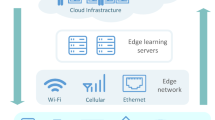Abstract
Deep learning is a promising way to get relevant information from IoT service sensor data embedded in complex situations. Due to its multifaceted structure, deep learning is better suited to the nature of computer drag. So, in the course of this article, we start by introducing deep IoT metrics into the computer environment. Because there is a limited amount of available bandwidth, we are designing a separate load-filling strategy to optimize the performance of deep IoT learning systems using computers (World Health Organization Epilepsy, http://www.who.int/mediacentre/factsheets/fs999/en/)
Access this chapter
Tax calculation will be finalised at checkout
Purchases are for personal use only
Similar content being viewed by others
References
World Health Organization Epilepsy, [online] http://www.who.int/mediacentre/factsheets/fs999/en/
M.-P. Hosseini, M.-R. Nazem-Zadeh, D. Pompili, K. Jafari-Khouzani, K. Elisevich, H. Soltanian-Zadeh, Comparative performance evaluation of automated segmentation methods of hippocampus from magnetic resonance images of temporal lobe epilepsy patients. Med. Phys. 43(1), 538–553 (2016)
M.-P. Hosseini, M. R. Nazem-Zadeh, D. Pompili, K. Jafari-Khouzani, K. Elisevich and H. Soltanian-Zadeh, Automatic and manual segmentation of hippocampus in epileptic patients mri, in 6th annual New York Medical Imaging Informatics Symposium (NYMIIS), 2015
B.M. Psaty, A.M. Breckenridge, Mini-sentinel and regulatory science-big data rendered fit and functional. N. Engl. J. Med. 370(23), 2165 (2014)
S. Schneeweiss, Learning from big health care data. N. Engl. J. Med. 370(23), 2161–2163 (2014)
S. Vahidian, S. Aïssa, S. Hatamnia, Relay selection for security-constrained cooperative communication in the presence of eavesdrop-per's overhearing and interference. IEEE Wireless Commun Lett 4(6), 577–580 (2015)
T.X. Tran, A. Hajisami, P. Pandey, D. Pompili, Collaborative mobile edge computing in 5G networks: New paradigms scenarios and challenges. IEEE Commun. Mag. 55(4), 54–61 (2017)
T.X. Tran and D. Pompili, Joint task offloading and resource allocation for multi-server mobile-edge computing networks, arXiv preprint arXiv:1705.00704 (2017)
M.-P. Hosseini, H. Soltanian-Zadeh, S. Akhlaghpoor, Computer-aided diagnosis system for the evaluation of chronic obstructive pulmonary disease on ct images. Tehran Univ Med J TUMS Publ 68(12), 718–725 (2011)
M.-P. Hosseini, A. Hajisami and D. Pompili, Real-time epileptic seizure detection from eeg signals via random subspace ensemble learning, IEEE International Conference on Autonomic Computing (ICAC) (2016)
N. Lu, T. Li, X. Ren and H. Miao, A deep learning scheme for motor imagery classification based on restricted boltzmann machines, IEEE Trans Neural Syst Rehabil Eng, 25, 566 (2016)
X. An, D. Kuang, X. Guo, Y. Zhao and L. He, A deep learning method for classification of eeg data based on motor imagery International Conference on Intelligent Computing, pp. 203–210, (2014)
S.-M. Shams, B. Afshin-Pour, H. Soltanian-Zadeh, G. Zadeh, S.C. Strother, Automated iterative reclustering framework for determining hierarchical functional networks in resting state fmri. Hum. Brain Mapp. 36(9), 3303–3322 (2015)
Z.V. Freudenburg, N.F. Ramsey, M. Wronkiewicz, W.D. Smart, R. Pless, E.C. Leuthardt, Real-time naive learning of neural correlates in ecog electrophysiology. Int J Mach Learn Comput 1(3), 269 (2011)
C.O. Rolim, F.L. Koch, C.B. Westphall, J. Werner, A. Fracalossi, G.S. Salvador, A cloud computing solution for patient's data collection in health care institutions. ETELEMED, 95–99 (2010)
T.H. Laine, C. Lee and H. Suk, Mobile gateway for ubiquitous health care system using zigbee and bluetooth, Proc. IEEE International Conference on Innovative Mobile and Internet Services in Ubiquitous Computing (IMIS), pp. 139–145, 2014
S. Yang and M. Gerla, Personal gateway in mobile health monitoring, Proc. IEEE International Conference on Pervasive Computing and Communications Workshops (PERCOM Workshops), pp. 636–641 (2011)
M. Mousaei and B. Smida, Optimizing pilot overhead for ultra-reliable short-packet transmission, arXiv preprint arXiv:1705.02753 (2017)
A. Sani, A. Vosoughi, Distributed vector estimation for power-and bandwidth-constrained wireless sensor networks. IEEE Trans. Signal Process. 64(15), 3879–3894 (2016)
A. Iraji, V.D. Calhoun, N.M. Wiseman, E. Davoodi-Bojd, M.R. Avanaki, E.M. Haacke, et al., The connectivity domain: Analyzing resting state fmri data using feature-based data-driven and model-based methods. NeuroImage 134, 494–507 (2016)
D.S. Barron, P.T. Fox, H. Pardoe, J. Lancaster, L.R. Price, et al., Tha-lamic functional connectivity predicts seizure laterality in individual tle patients: Application of a biomarker development strategy. NeuroImage Clin 7, 273–280 (2015)
X. He, G.E. Doucet, M. Sperling, A. Sharan, J.I. Tracy, Reduced thalamocortical functional connectivity in temporal lobe epilepsy. Epilepsia 56(10), 1571–1579 (2015)
D. Meunier, R. Lambiotte, E.T. Bullmore, Modular and hierarchically modular organization of brain networks. Front. Neurosci. 4, 200 (2010)
G.J. Ortega, R.G. Sola, J. Pastor, Complex network analysis of human ecog data. Neurosci. Lett. 447(2), 129–133 (2008)
G. Alarcon, J.G. Seoane, C. Binnie, M.M. Miguel, J. Juler, C. Polkey, et al., Origin and propagation of interictal discharges in the acute electrocorticogram. Implications for pathophysiology and surgical treatment of temporal lobe epilepsy. Brain 120(12), 2259–2282 (1997)
K. Deb, Multi-objective evolutionary algorithms: Introducing bias among pareto-optimal solutions, in Advances in Evolutionary Computing, (Springer, 2003), pp. 263–292
A. Rahimpour, A. Taalimi and H. Qi, Feature encoding in band-limited distributed surveillance systems, ICASSP 2017-IEEE International Conference on Acoustics Speech and Signal Processing (2017)
M.-P. Hosseini, H. Soltanian-Zadeh, K. Elisevich and D. Pompili, Cloud-based deep learning of big eeg data for epileptic seizure prediction, IEEE Global Conference on Signal and Information Processing (GlobalSIP) (2016)
S. Minaee and Y. Wang, Fingerprint recognition using translation invariant scattering network, IEEE Signal Processing in Medicine and Biology Symposium 2015 (2015)
M. Rahmani, G. Atia, High dimensional low rank plus sparse matrix decomposition. IEEE Trans. Signal Process. 2017 (2017)
Author information
Authors and Affiliations
Editor information
Editors and Affiliations
Rights and permissions
Copyright information
© 2021 Springer Nature Switzerland AG
About this chapter
Cite this chapter
Rajpoot, V., Patel, A., Manepalli, P.K., Saxena, A. (2021). Deep Learning and Edge Computing Solution for High-Performance Computing. In: Suresh, A., Paiva, S. (eds) Deep Learning and Edge Computing Solutions for High Performance Computing. EAI/Springer Innovations in Communication and Computing. Springer, Cham. https://doi.org/10.1007/978-3-030-60265-9_1
Download citation
DOI: https://doi.org/10.1007/978-3-030-60265-9_1
Published:
Publisher Name: Springer, Cham
Print ISBN: 978-3-030-60264-2
Online ISBN: 978-3-030-60265-9
eBook Packages: EngineeringEngineering (R0)




